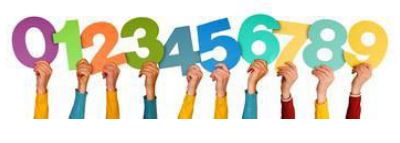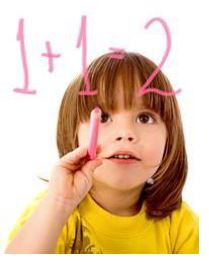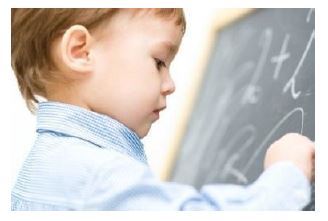Students in the United States are falling behind their international counterparts in math proficiency.i This is a concern for educators and the general public. Understanding of math concepts is important, as preschool children’s math knowledge predicts their later mathematics achievement.ii, iii Early numeracy skills (remembering small numbers of objects) fostered in the home and classroom also might influence future developments in number and math skills. A strong foundation in number sense can also help children develop problem-solving skills.v
Number sense encompasses a broad understanding of the concept of numbers. The National Mathematics Advisory Panel defines it as an ability to identify numbers and understand quantities associated with each number, count numbers, and add and subtract numbers.i
Preschool children learn number sense through play and continuous exploration in their natural environment. A quality home learning environment seems to shape children’s numeracy skills at preschool entry, but a quality preschool learning environment influences the future development of children’s numeracy skills.vi Preschool teachers can organize experiences for children by intentionally setting up the environment to promote these experiences. They can help preschoolers learn and explore number identification (0-10), counting 1 to 10 or 1 to 20, and doing simple addition and subtraction of small numbers with hands-on activities using everyday materials.
In this fact sheet, we focus on the following number sense skills: number identification, counting and one-to-one correspondence, and addition and subtraction.
Number Identification
Number identification is the ability to identify the number that corresponds with a quantity. This is also called number representation or number recognition. For example, it is the ability to identify that the symbol “7” refers to the word “seven” and a quantity of seven objects.

Ideas to try:
Numbers Everywhere: Point out and name numbers on street signs, houses and buildings while you are outside or are on a field trip. Find numbers around the classroom on telephones, clocks, number charts, magnetic numbers and calendars.
Calculator Fun: Give children calculators and let them play with the numbers. Ask them to find the number that shows how old they are and show them the number that shows how many crayons (or other items) they use. Have them type in the numbers 0-10 in order.
Magnetic Numbers: Purchase a package or two of magnetic numbers. Allow children to match up pairs of the same number and put the numbers in order. Use a cookie sheet or magnetic board to practice.
Telling Time: Instead of reading times on a digital clock, try to use an analog watch with numbers and moving hands. Concentrate on telling the time on the hour at first. Ask, “How many big numbers are on the clock?”
Play Board Games or Card Games: Play simple board games or card games to count spaces on the board and objects used in the game, and to recognize printed numbers.
Counting and One-to-one Correspondence
Counting is memorizing numbers in correct order (1, 2, 3, 4, 5…). Many preschool children (4 years old) can count up to five, some can count up to 10, and a few can count to 20 or higher. One-to-one correspondence is the skill of pairing or matching objects so that one object equals one number. That is, when we say, “one,” we count one object and when we say, “two,” we count one more object.
Ideas to try:
Counting Anything and Everything: Count real objects around the classroom. By counting real things, preschoolers can use their own experiences with objects to understand numbers better. Teachers can have children count food items (how many beans are on a plate), have them measure quantities when cooking (1/2 cup water in a recipe), or count coins together.
Counting Songs: Recite nursery rhymes and sing songs that include counting such as: One, Two, Buckle My Shoe; Five Little Monkeys Jumping on the Bed; This Old Man; Five Little Ducks; and The Ants Go Marching One by One. This will give children an opportunity to practice counting in a playful manner.
Counting Books: Read counting books with children. These activities will help children actually say aloud the numbers as they see or hear numbers and count objects together. Some good counting books include: Over in the Meadow by Ezra Jack Keats, The Very Hungry Caterpillar by Eric Carle, Count by Denise Fleming, Five Little Monkeys by Eileen Christelow, Ten Black Dots by Donald Crews and Anno’s Counting Book by Mitsumasa Anno.
Clapping Numbers: While waiting in line, have children count as high as they can go. Have them clap as they say each number name. Add a new number each time you practice.
Mealtime Numbers: Have children count at mealtime by matching up napkins and spoons, counting plates and cups for each friend and teacher, or counting to make sure there are enough chairs for everybody for mealtime.
Sticker Counting: Count the steps as children go up and down, count the number of times the phone rings before you answer it, count the number of toys you put in a box, or count how many books you read during free play. Encourage children to put stickers on a piece of paper and have them touch each one as they count anything.
Addition and Subtraction
Addition and subtraction for preschoolers should be fun, hands-on activities. Using objects, talk to children about taking one away or adding one more. Children can practice simple addition and subtraction using small toys and blocks. Do not require preschoolers to memorize equations or respond to flash-card equations. These activities are not developmentally appropriate for preschoolers. Many preschool children can nonverbally and mentally add up to four and their subtraction counterparts (3+1, 4-1, 2+1, 1+1).

Ideas to try:
Add and Subtract Everything: Collect a variety of materials that can be used for hands-on addition and subtraction. Plastic bottle caps, old buttons, small blocks, puzzle pieces and old keys will all work. Collect them in a bag or jar and pick a time to add or subtract them. During snack time, encourage children to add and subtract goldfish or other small crackers.
Bowling for Addition and Subtraction: Using water bottles or soda bottles, create your own bowling set. Ask children to number each bottle from 1 to 10, and arrange the bottles in a triangular shape at the end of a long hallway or uncarpeted room, with one pin in the front, two behind it, three behind those and so on. Take turns rolling the ball toward the pins and see how many you can roll over in one try. Count up the numbers on each pin that gets knocked over and pins that don’t get knocked over.
Make 1, 2, 3 or 4: Linking blocks are a perfect item to explore addition and subtraction because they can easily be put together and taken apart. Give a child a total of 4 linking blocks, and have the children make 1, 2, 3 or 4 by putting together linking blocks and taking apart linking blocks.

Conclusion
Preschool children can build the foundations they need to achieve in mathematics with the support of preschool teachers. Early exposure to number activities and additional opportunities to practice number skills will help children feel more comfortable with math and numbers. Teachers can help preschoolers learn and explore number sense with hands-on activities
Fun Books to Share
Carle, E. 1, 2, 3, to the Zoo: A Counting Book. Philomel Books.
Crews, D. Ten Black Dots Board Book. Greenwillow Books.
Lionni, L. Inch by Inch. Knopf Books for Young Readers.
Seuss, D., & Geisel, T. S. One Fish Two Fish Red Fish Blue Fish. Random House Books for Young Readers.
References
i National Mathematics Advisory Panel (2008). Foundations for Success: The Final Report of the National Mathematics Advisory Panel. Washington, DC: US Department of Education.
ii Clements, D. H., & Sarama, J. (2011). Early Childhood Mathematics Intervention. Science, 333, 968-970.
iii Jordan, N. C., Kaplan, D., Locuniak, M. N., & Ramineni, C. (2007). Predicting First Grade Math Achievement from Developmental Number Sense Trajectories. Learning Disabilities Research and Practice, 22(1), 36–46.
iv Starteky, P., Spelke, E. S., & Gelman, R. (1990). Numerical abstraction by human infants. Cognition, 36(2), 97-127.
v Witzel, B. S., Ferguson, C. J., & Mink, D. V. (2012). Number sense: Strategies for helping preschoolers through grade 3 children develop math skills. Young Children, 57(3), 89-94.
vi Anderson, Y., Rossbach, H., Weinert, S., Ebert, S., Kuger, S., Lehrl, S., & von Maurice, J. (2012). Home and preschool learning environments and their relations to the development of early numeracy skills. Early Childhood Research Quarterly, 28, 231-244.


